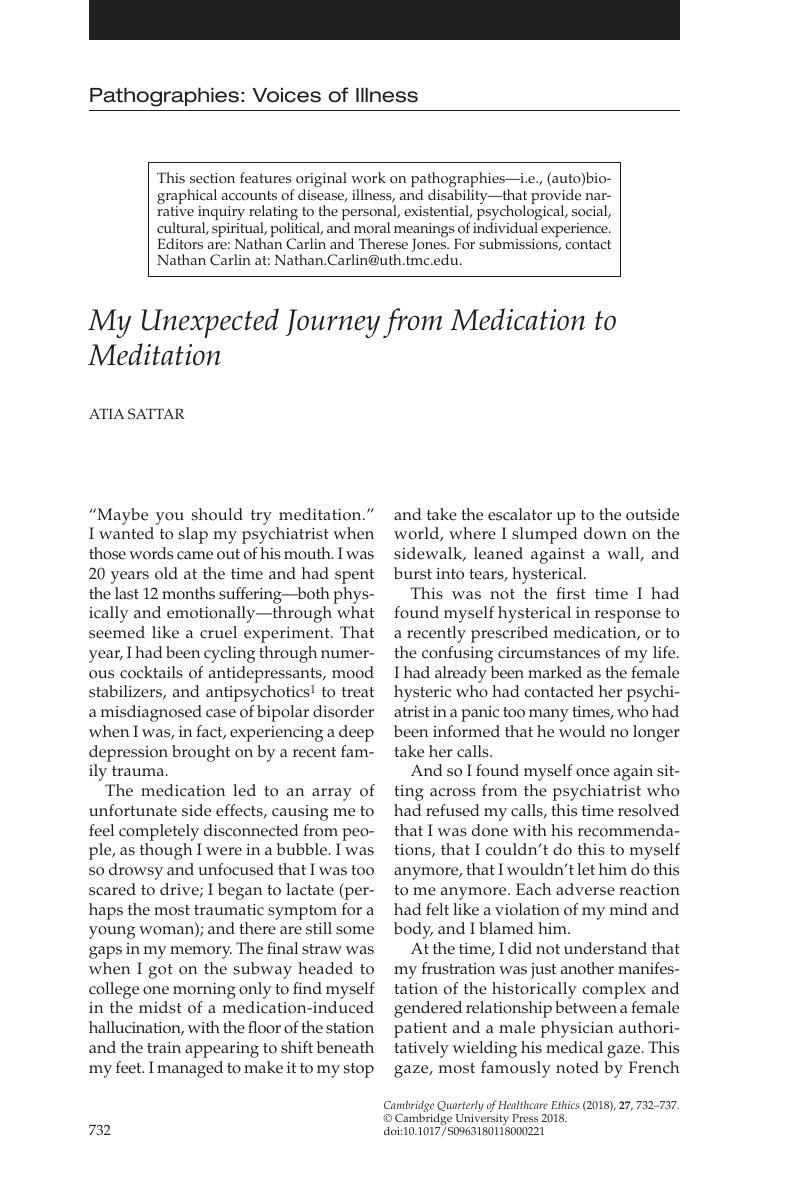No CrossRef data available.
Article contents
My Unexpected Journey from Medication to Meditation
Published online by Cambridge University Press: 10 September 2018
Abstract

- Type
- Departments and Columns
- Information
- Cambridge Quarterly of Healthcare Ethics , Volume 27 , Special Issue 4: Clinical Neuroethics , October 2018 , pp. 732 - 737
- Copyright
- Copyright © Cambridge University Press 2018
Footnotes
This section features original work on pathographies—i.e., (auto)biographical accounts of disease, illness, and disability—that provide narrative inquiry relating to the personal, existential, psychological, social, cultural, spiritual, political, and moral meanings of individual experience. Editors are: Nathan Carlin and Therese Jones. For submissions, contact Nathan Carlin at: [email protected].
References
Notes
1. I remember there being at least nine medications, although all their names escape me. The ones I do remember include Resperdal, Seroquel, Lamictal, Wellbutrin, Buspar, and Lexapro.
2. Foucault, M. The Birth of the Clinic: An Archaeology of Medical Perception. New York: Pantheon Books; 1973, at 14.Google Scholar
3. See note 2, Foucault 1973, at 9.
4. American realist painter Thomas Eakins (1844–1916) is perhaps most famous for his depictions of medical practice, in particular the anatomy lecture. See The Gross Clinic (1875) and The Agnew Clinic (1889).
5. Here are just a few examples of the extensive literature on the role and decline of empathy in medicine: Lee TH. An Epidemic of Empathy in Healthcare: How to Deliver Compassionate, Connected Patient Care That Creates a Competitive Advantage. Columbus, OH: McGraw Hill; 2016; Halpern, J. From Detached Concern to Empathy: Humanizing Medicine. Oxford: Oxford University Press; 2011;Google Scholar Spiro, HM, McCrea Curnen, MG, Peschel, E, St. James, D. Empathy and the Practice of Medicine: Beyond Pills and the Scalpel. New Haven: Yale University Press; 1996.Google Scholar
6. Daston, L, Galison, P: Objectivity. New York: Zone Books; 2007, at 17.Google Scholar
7. See note 6, Daston, Galison 2007, at 17.
8. Merleau-Ponty M. Eye and mind. In: The Primacy of Perception. Edie JE, ed. Dallery C, trans. Evanston, IL: Northwestern University Press; 1964, at 178. Merleau-Ponty’s specific philosophy, called “phenomenology,” foregrounds direct experiential contact in the study of an object and its deeper meaning.
9. Naht Hahn, T. The Miracle of Mindfulness: An Introduction to the Practice of Meditation. Boston: Beacon Press; 1975, at 15.Google Scholar


